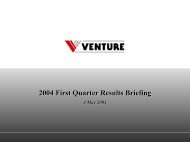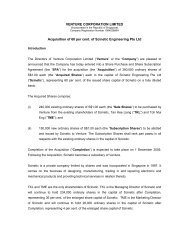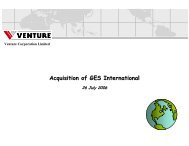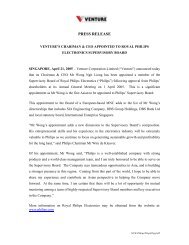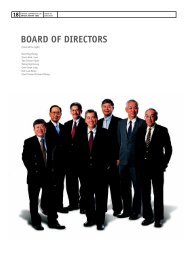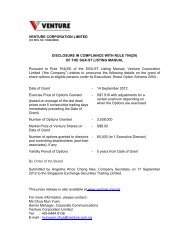Annual Report 2006 - Venture Corporation Limited
Annual Report 2006 - Venture Corporation Limited
Annual Report 2006 - Venture Corporation Limited
Create successful ePaper yourself
Turn your PDF publications into a flip-book with our unique Google optimized e-Paper software.
notes to financial statements<br />
December 31, <strong>2006</strong><br />
2 SUMMARY OF SIGNIFICANT ACCOUNTING POLICIES (Cont’d)<br />
In respect of available-for-sale equity instruments, any subsequent increase in fair value after an impairment loss,<br />
is recognised directly in equity.<br />
Financial liabilities and equity instruments<br />
Classification as debt or equity<br />
Financial liabilities and equity instruments issued by the group are classified according to the substance of the<br />
contractual arrangements entered into and the definitions of a financial liability and an equity instrument.<br />
Equity instruments<br />
An equity instrument is any contract that evidences a residual interest in the assets of the group after deducting<br />
all of its liabilities. Equity instruments are recorded at the proceeds received, net of direct issue costs.<br />
Financial liabilities<br />
Trade and other payables are initially measured at fair value, net of transaction costs, and are subsequently<br />
measured at amortised cost, using the effective interest rate method, with interest expense recognised on an<br />
effective yield basis.<br />
Interest-bearing bank loans and overdrafts are initially measured at fair value, and are subsequently measured<br />
at amortised cost, using the effective interest rate method. Any difference between the proceeds (net of<br />
transaction costs) and the settlement or redemption of borrowings is recognised over the term of the borrowings<br />
in accordance with the group’s accounting policy for borrowing costs (see below).<br />
The effective interest method is a method of calculating the amortised cost of a financial liability and of<br />
allocating interest expense over the relevant period. The effective interest rate is the rate that exactly discounts<br />
estimated future cash payments through the expected life of the financial liability, or, where appropriate, a<br />
shorter period.<br />
Derivative financial instruments<br />
The group’s activities expose it primarily to the financial risks of changes in foreign exchange rates.<br />
The group uses derivative financial instruments (primarily foreign currency forward contracts) to hedge its risks<br />
associated with foreign currency fluctuations relating to certain firm commitments and forecast transactions.<br />
The use of financial derivatives is governed by the group’s policies approved by the board of directors, which<br />
provide guidance on the use of financial derivatives consistent with the group’s risk management strategy. The<br />
group does not use derivative financial instruments for speculative purposes.<br />
Derivatives are initially recognised at fair value at the date a derivative contract is entered into and are subsequently<br />
remeasured to their fair value at each balance sheet date. The resulting gain or loss is recognised in profit or loss<br />
immediately unless the derivative is designated and effective as a hedging instrument, in which event the timing<br />
of the recognition in profit or loss depends on the nature of the hedge relationship.<br />
Embedded derivatives<br />
Derivatives embedded in other financial instruments or other host contracts are treated as separate derivatives<br />
when their risks and characteristics are not closely related to those of the host contracts and the host contracts<br />
are not measured at fair value with changes in fair value recognised in profit or loss.<br />
annual report <strong>2006</strong><br />
45



